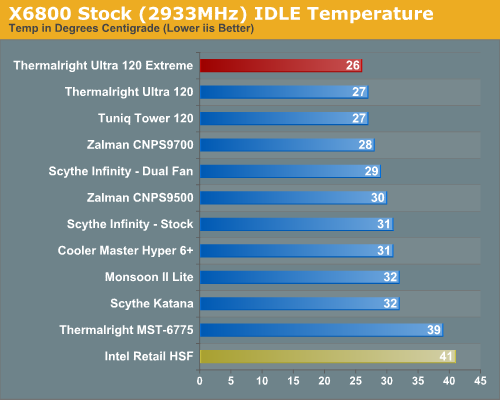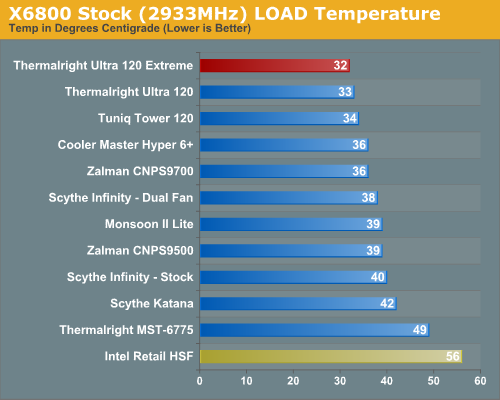Thermalright Ultra 120 Extreme: Is More Better?
by Wesley Fink on March 7, 2007 12:05 AM EST- Posted in
- Cases/Cooling/PSUs
Cooling at Stock Speed
Some users will never overclock their CPU, but they still want to run the coolest CPU temperatures possible to enhance stability and extend CPU life. The Thermalright Ultra 120 Extreme, as in the recent Ultra 120 review, was tested using a 120mm Scythe S-Flex SFF21F fan.

The Thermalright Ultra 120 was outstanding in our stock cooling tests; the Ultra 120 Extreme is even better. Where the very good Intel stock cooler keeps the X6800 at 41C at idle, the Ultra 120 manages 27C, which matched the Tuniq Tower 120 as best we have ever measured in testing at stock speeds. The Ultra 120 Extreme sets a new record at 26C, which is the best performance we have ever measured at stock idle.
The stress test simulates running a demanding contemporary game. The Far Cry River demo is looped for 30 minutes and the CPU temperature is captured at 4 second intervals with the NVIDIA monitor "logging" option. The highest temperature during the load test is then reported. Momentary spikes are ignored, as we report a sustained high-level temp that you would expect to find in this recording configuration. Cooling efficiency of the Thermalright Ultra 120 Extreme was compared under load conditions at stock speed to the Ultra 120, the Intel retail HSF and other recently tested CPU coolers.

The Ultra 120 Extreme under load at stock speeds reached a maximum temperature of 32C. This breaks the old performance record just set by the Ultra 120 at 33C. This compares to the Tuniq 34C and the Cooler Master Hyper 6+ and Zalman 9700 at 36C, and is the best stock load performance we have measured at AnandTech with an air cooler.
At stock speed the Ultra 120 Extreme upgrade shows it is effective at lowering processor temperatures. The Ultra 120 Extreme was 1C cooler at idle than the Ultra 120 and Tuniq - our previous best performers. Under stress that improvement grows to 2C relative to the Tuniq while remaining at 1C compared to the current Ultra 120. With the Thermalright Ultra 120 Extreme providing the best in air cooling, we took a closer look at cooling along with overclocking.
Some users will never overclock their CPU, but they still want to run the coolest CPU temperatures possible to enhance stability and extend CPU life. The Thermalright Ultra 120 Extreme, as in the recent Ultra 120 review, was tested using a 120mm Scythe S-Flex SFF21F fan.

The Thermalright Ultra 120 was outstanding in our stock cooling tests; the Ultra 120 Extreme is even better. Where the very good Intel stock cooler keeps the X6800 at 41C at idle, the Ultra 120 manages 27C, which matched the Tuniq Tower 120 as best we have ever measured in testing at stock speeds. The Ultra 120 Extreme sets a new record at 26C, which is the best performance we have ever measured at stock idle.
The stress test simulates running a demanding contemporary game. The Far Cry River demo is looped for 30 minutes and the CPU temperature is captured at 4 second intervals with the NVIDIA monitor "logging" option. The highest temperature during the load test is then reported. Momentary spikes are ignored, as we report a sustained high-level temp that you would expect to find in this recording configuration. Cooling efficiency of the Thermalright Ultra 120 Extreme was compared under load conditions at stock speed to the Ultra 120, the Intel retail HSF and other recently tested CPU coolers.

The Ultra 120 Extreme under load at stock speeds reached a maximum temperature of 32C. This breaks the old performance record just set by the Ultra 120 at 33C. This compares to the Tuniq 34C and the Cooler Master Hyper 6+ and Zalman 9700 at 36C, and is the best stock load performance we have measured at AnandTech with an air cooler.
At stock speed the Ultra 120 Extreme upgrade shows it is effective at lowering processor temperatures. The Ultra 120 Extreme was 1C cooler at idle than the Ultra 120 and Tuniq - our previous best performers. Under stress that improvement grows to 2C relative to the Tuniq while remaining at 1C compared to the current Ultra 120. With the Thermalright Ultra 120 Extreme providing the best in air cooling, we took a closer look at cooling along with overclocking.










54 Comments
View All Comments
PICBoy - Thursday, March 8, 2007 - link
Oops! actually on every table and image the name "PLUS" is used instead of Extreme. My bad, that's all!Spoelie - Wednesday, March 7, 2007 - link
For the quieter power supplies, I'd look at the Seasonic S12+ series, and the Corsair HX series for a higher powered system.Why? That particular Seasonic is by many a reviewsite considered to be one of the quietest around, and starts ramping up the fan around 250w (depending on how much case cooling you have). The corsair is ~2dB louder in the low wattage scale, but only starts ramping up around 300w given the same conditions.
The ramping-up spot is pretty important, for example, before I had a Venice+x850xt and CM RealPower psu, this proved to be a pretty quiet combination. However, once I upgraded to an oc'd denmark+x1950xt, idle power jumped up and the PSU was already ramping up during idle. It only got worse under load, and I couldn't stand the noise at all. I replaced the PSU with a Corsair HX and have yet to actually hear it ramp up, the other TC fans in the system drown out any noise it makes.
A passively cooled mobo is standard these days, and a minimum of case airflow should be considered as well.
Frumious1 - Wednesday, March 7, 2007 - link
Noise and performance tend to be conflicting goals. Sure, you can get a passively cooled motherboard, and with a down-facing PSU fan you can probably go fanless on the CPU (with something like an Ultra 120/120+). You should probably still mount a low RPM case fan, however, as a "good" PSU that doesn't ramp up fan speed is also not going to move a lot of air.The problem is, if you want to overclock all of that silent/fanless stuff becomes much more difficult (if not impossible). 680i motherboards are known to use quite a bit of power, and the chipsets definitely require active cooling if you want to do some real overclocking. Then you get higher CPU temperatures, and without active cooling on the CPU you tend to rapidly increase temperatures until the system crashes/shuts down.
The cooling test bed appears to be configured as a reasonable compromise between extremes. Some people want silence, some people want performance and quiet be damned, but most are just looking to build a reasonably fast and reasonably quiet PC - hopefully without breaking the bank. Besides, as Wes mentions above, SPCR already covers the "silence above all" market quite well. Why go up against them when there's a vast user base that has more moderate needs?
Spoelie - Wednesday, March 7, 2007 - link
The thing is, with the right aftermarket parts, you can have a totally silent pc AND a high performance/overclocked one. There isn't a need for compromise, as long as you don't want to break any world records. I mean, even in this review, they have a core2 duo overclocked to 3.9ghz without any case air flow. I call that pretty high performance.http://www.jaha.be/ashop/?mod=product&cat_id=5...">http://www.jaha.be/ashop/?mod=product&cat_id=5... Thermalright HR05 for the chipset, this is a passive heatsink that dropped my chipset temperature 10°C over the standard HSF combo. Granted, I only have the DFI nForce4, but there are plenty of high performance alternatives for the 680i. Thermalright also has a good passive cooler for scorching hot ram: http://www.jaha.be/ashop/?mod=product&cat_id=5...">http://www.jaha.be/ashop/?mod=product&cat_id=5...
Choose a good case like the Antec P-series, put the silent psu's mentioned earlier in there, change the exhaust fan for a nice 1000rpm nexus/papst, get the reviewed heatsink (or a tuniq/scythe, it's not like i'm a thermalright fan) with another 1000rpm nexus/papst and you're set. All modern gpu standard cooling solutions can be made extremely quiet at idle with some software tweaking, so you'll only hear them when you're gaming. I guarantee the above combination will support heavy overclocking and be extremely quiet at the same time.
Spoelie - Wednesday, March 7, 2007 - link
Hmmm just want to add that you do have a point about the moderate user not going to put all that aftermarket stuff in their pc, so the thing about the differing user bases is right. On the other hand, a moderate user isn't going to provide extra active cooling to overclock (or even have) a 680i.Baked - Wednesday, March 7, 2007 - link
Nice review. Have the Ultra-120 on my C2D system. When I get the chance to get a C2Q, the Ultra-120+ is going in there.nrb - Wednesday, March 7, 2007 - link
...is you need to actually benchmark the Tuniq Tower using the same S-Flex fan.Wesley Fink - Wednesday, March 7, 2007 - link
One more time. If a cooler comes with a fan we test with that fan. We chose the S-Flex because the Ultra 120 and 120+ do NOT come with a fan, and the other fans we had available would not fit the Ultra 120/120+ clips. We may well test 120mm fans in the future, but we do not plan to do cooler reviews using several different aftermarket fans as a routine test procedure. We do our best to test the cooler as shipped.Having said that, it is likely a good idea to compare a few of the top-performing coolers using the same top-performing fan in a separate review. We agree that would be interesting.
PCTechNow - Wednesday, March 7, 2007 - link
Why not go back and test the other coolers with the same fan used in this review? It would at least show if the fan or the cooler is making the difference. Better yet, take the fan off the Tuniq and test with it on the Thermalrights and see what the difference is.dm0r - Wednesday, March 7, 2007 - link
Air cooling is gettin better and quieter this days...good to see a cooler that improves them both.I was choosing tuniq tower for my next desktop system but i liked the Thermalright ultra 120 in Noiseless cooling.Thanks AT for this review.BTW Any results difference between 120 and 120+ in noiseless cooling?